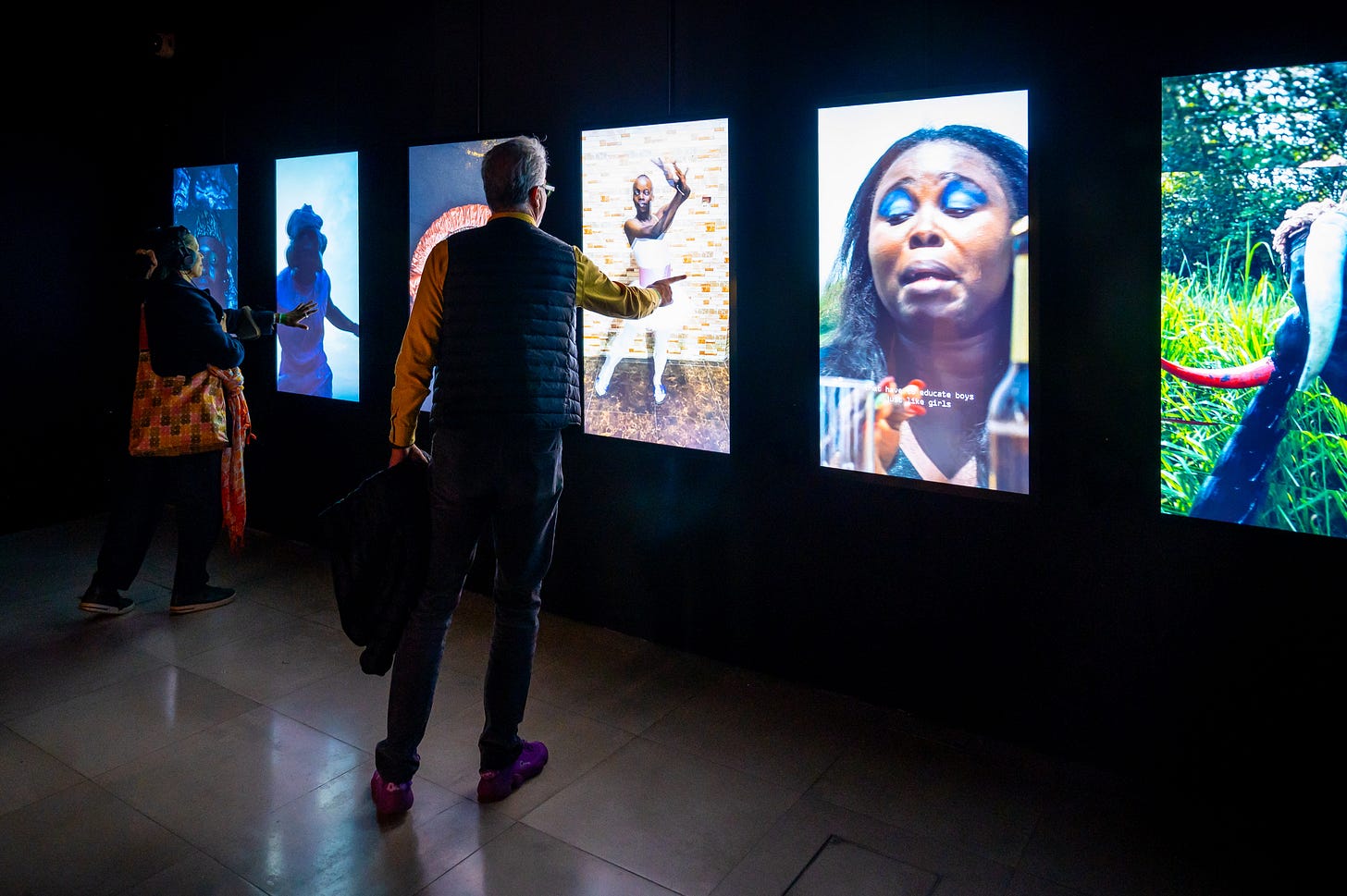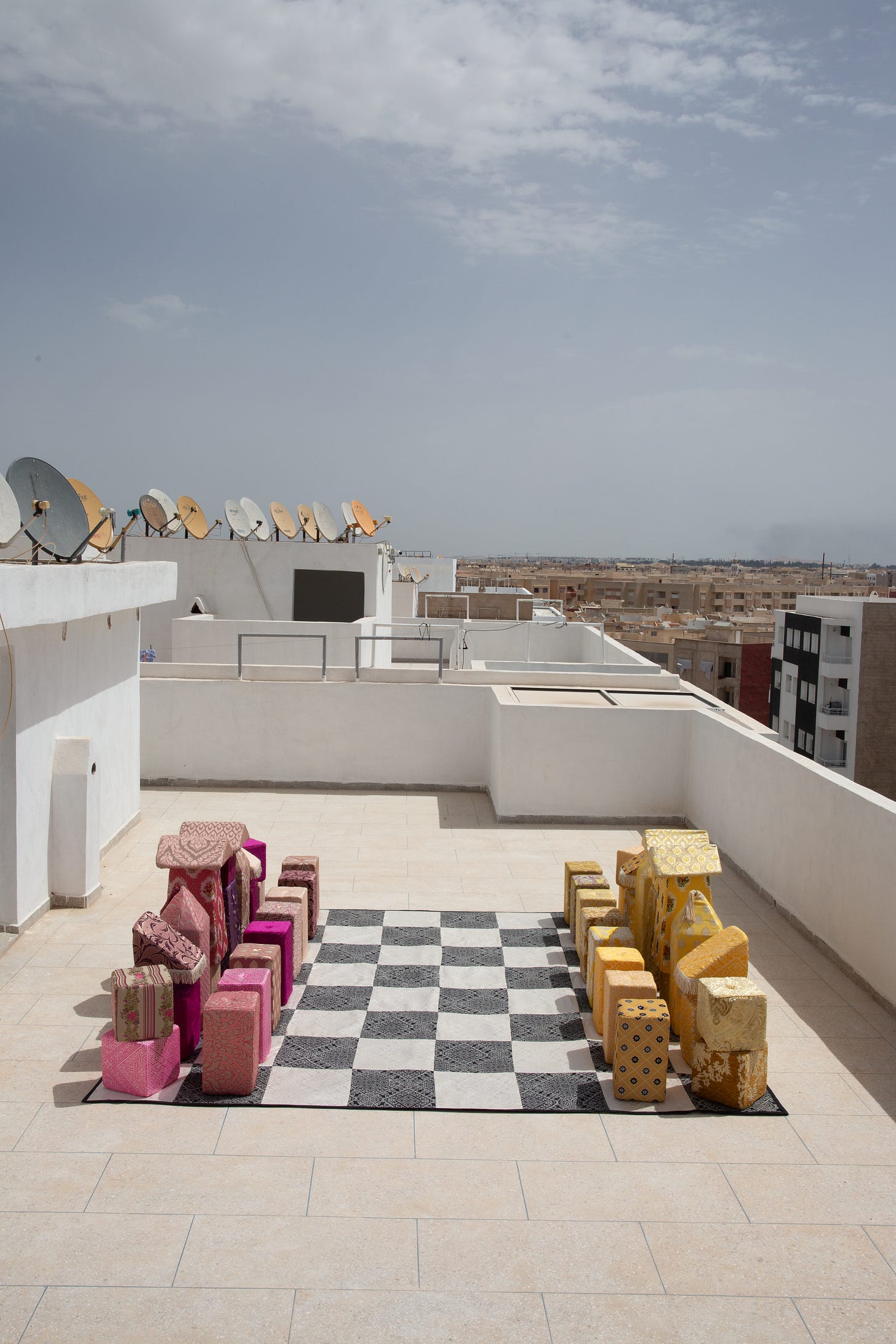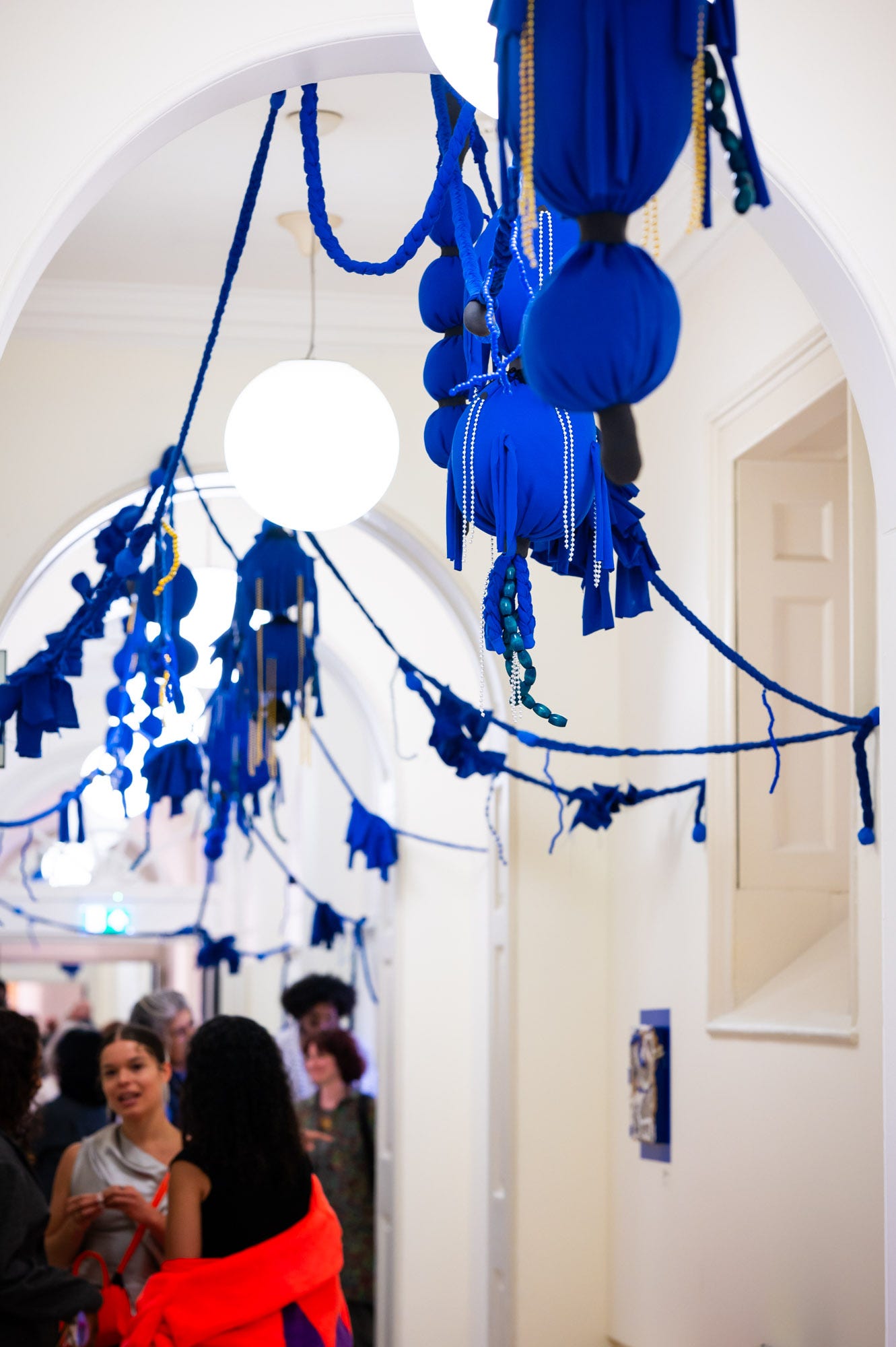
This issue is too long to view as an email; tap the headline to read it in full in your browser or on the Substack app.
Unveiled over the latter half of that heightened period of flurried artistic and commercial activity in October ubiquitously dubbed ‘Frieze Week’, the 2024 London iteration of the 1-54 African Art Fair is a welcome irruption in the increasingly mechanical modality of engagement that threatens to take over this saturated week of art viewing.
The fair is located in Somerset House between 10-13th October, and is the last of its three-pronged series, following its early and mid-year openings in Marrakech and New York. This year marks its 12th instalment since its founding in 2013 by Touria El-Glaoui, where it is hosting over sixty galleries from twenty-three countries, and the highest number of first-time exhibitors to date. As a slight digression, it is worth noting that the Africa as a continent has almost double that amount of countries.
The show is spread over several floors of Somerset House’s grand yet cosily lit building. To borrow its apt description from Lou’s account of the show, the building’s ‘higgledy-piggledy’ architectural design lends itself to the bountiful and immersive journey through the works on display. Read on for my highlights:
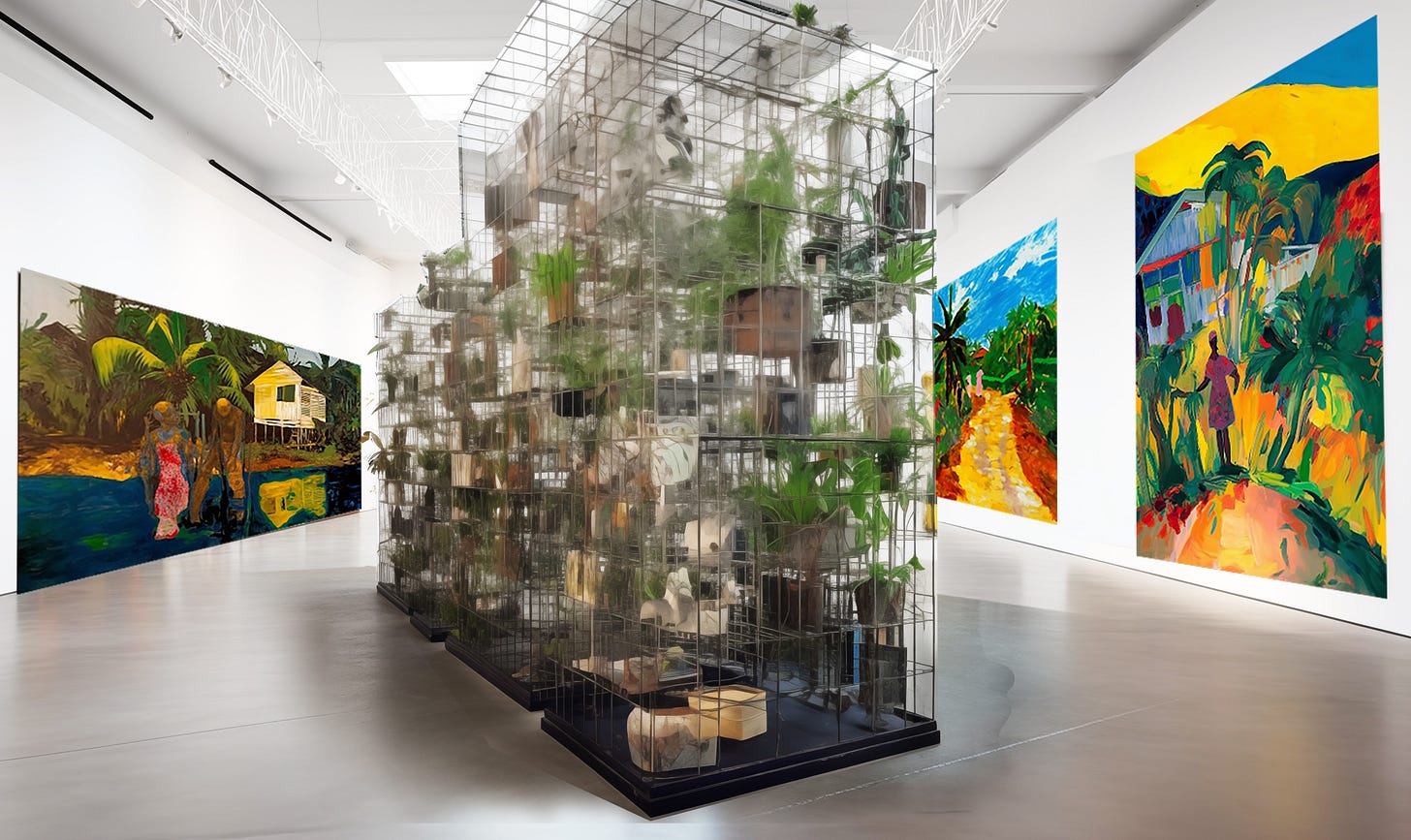
Sol Golden-Sato: Ancestral Lungs
Sol Golden-Sato’s Ancestral Lungs is one of the few larger installations that confidently takes over the openness of the gallery’s lower ground space. Collaborating with The Bomb Factory Art Foundation, the London-based Malawian artist’s piece is comprised of a central metal grid structure and multiple surrounding paintings. The latter are brightly coloured, yet unsettling representations of nature and people as disjointed and dislocated from each other. In Lord of the Flies, a group of people dance in tandem at the precipice of a waterfall, the mountainous backdrop so looming behind them that it seems to almost be caving in on itself. Golden-Sato’s works explore the interconnectedness of the (forced) movement of people and plants across continents and its geographical and environmental implications. The installation at the centre of the room is a metal grid enveloping an array of plants, books, masks and records. Golden-Sato roots these technological, carceral, cultural and ecological objects in historical considerations of empire and exploitation. Wole Soyinka’s Madmen and Specialists can be spotted propped up, along with a record of ‘What’s Going On’ by Marvin Gate and Tsitsi Dangarembga’s This Mournable Body.
Sarah Owuso Dogan: I am my sister’s keeper
Along the same corridor, ‘Dreaming in Colour’ – a cultural exchange and fund programme which constitutes part of the My Runway Group and fits within this year’s 1-54 ‘Special Projects’ - has a display space featuring four Ghanaian artists. Here, Sarah Owuso Dogan’s I am my sister’s keeper is particularly eye-catching – a mesmerising portrait of two people comfortably adrift on a striped inflatable, all bright blues and reflected light.
Baloji: Augure: Infinite Trolling
One of the few lens-based mixed media inclusions in this year’s fair was found further along this space, a video installation by the Belgian-Congolese artist Baloji. Augure: Infinite Trolling is comprised of several screens hung along a wall, through which the short videos they play the viewer can physically flick through. It is an effect intended to equally emphasise each sequence, drawing attention to the ways in which we prioritise narratives and consume information.
Megan Gabrielle Harris: Night in Soho
The feeling upon looking at Megan Gabrielle Harris’s painted portrait series is akin to that of coming across a window and being immediately compelled to peer closer and clarify whether it is indeed a window, a distorted magnifying glass, or a glimpse into another dimension that we are looking at. Night in Soho is a kaleidoscopic and in ways, mystical, portrait of two stylish women sat in conversation, the twisted and blurry yellows and greens of the background warping into each other, as if the figures are travelling through a sort of time-lapse. Two scenic landscapes adorn the setting in the background, although whether we are viewing them through a screen, window or on a canvas it is uncertain. Are they sat in a room or in a plush automobile that is zooming through the night? The play on dimensions makes you doubt both. Nonetheless, these reference points anchor the scene in a fixed stillness, jarring the illusion of movement through space or time. This distorted scene-setting is visible through her portrait series, in Serenade and Paraiso, for example, throwing into disarray the assured proximity of the viewer to both the paintings and the realities of the world which its subjects bit.

Oumar Kntitled (Two Women with Thatched Rood House) and Untitled (Man Standing in a Courtyard)
Oumar Ka’s photographic portraiture is comprised of dramatic and sleek stagings of individual and grouped subjects of two or three. Ka’s work is represented by Axis Gallery and is here located in a top-floor corridor of Somerset House. Particularly eye-catching given their location within a room made up of predominantly paintings and sculpture, the photographs see the figures meeting our gaze through the camera. A sheet hangs behind each of them – a motif-like element of theatricality to accompany the cinematic feel achieved by the black and white lens of the Senegalese photographer.
Sophia Kacimi: Zoubida
In other parts of the fair, we see more playful inclusions. An example is Zoubida, the French-Moroccan artist Sophia Kacimi’s take-over of the back corridor of the lower ground floor. Domestic furniture is set up and scattered along this space – clothes racks, plush seats, a tv – and is amusingly disrupted by a pink and orange organisation of upholstered stools. They are positioned along a chess-like black and white rug that is splayed out in the middle of it all. It is a fun and homely invitation to playfully examine the role of craft, fashion and societal hierarchy within the parameters of domesticity.
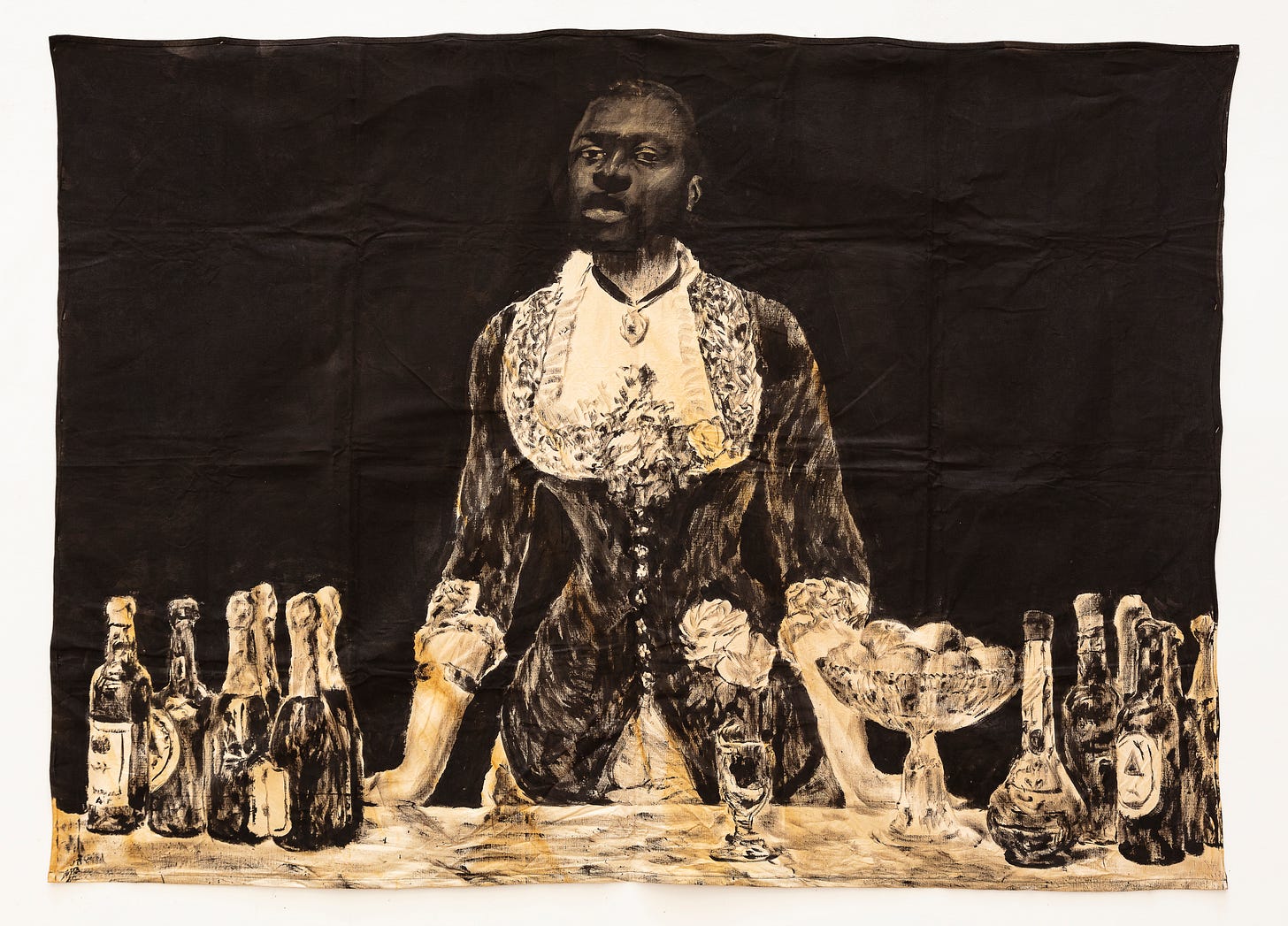
Theresa Weber, Zanele Muholi & Romeo Mivekannin
The fair weaves and bursts its way through the windy corridors and sub-sections of the East and West wings of Somerset House, with Theresa Weber’s material installation Fruits of Hope hooked along the ceiling of the corridor, guiding the path from room to room. The feeling is that of bobbing along and dipping into that which is particularly gaze-catching – whether that be Zanele Muholi’s beaded self-portrait on a canvas, an experimentation with material and form within the confines of their familiar black and white documentative frame; or Romeo Mivekannin’s grand and textured portraits that brazenly and almost comedically insert the artist in the revisits of classical portraiture.
The fair is limited by its almost total dedication to painting and sculpture as the dominant forms of art practise showcased on this year’s circuit, not to mention its restricted representation of artists working throughout the African continent (note my earlier comment on the relatively small figure of twenty-three African countries being represented through artist nationalities this year – a feature not uncommon in recent, supposedly expansive exhibitions of ‘African art’ in the UK and Europe). Yet elements of play, experimentation and subversion exist even within these more traditional forms of art, and it is these disruptive, at time wondrous, inclusions that ensure a delightful and recalibrating experience of art engagement, ironically yet unsurprisingly, so rare to find in the busiest week of the London art calendar.
Thank you Anne
Hey it’s Lou, please join me in thanking Anne for her brilliant contributions to Shade Art Review through it’s launch year. She’ll be taking a break for a few months whilst she settles into her MA at Goldsmith’s and we will also be busy working behind the scenes on special projects. Anne will join us again for her regular spotlight features in January 2025. I have made this Spotlight feature accessible to all subscribers. Enjoy!
New podcast incoming
This coming Tuesday 22nd October, I’m launching a new series of conversations made in collaboration with Freelands Foundation. Some of you may remember that in 2022 Larry Achiampong and I came together to launch Visualise: The Runnymede Trust and Freelands Foundation report on Race & Inclusion in Secondary School Art Education.
The report examines the current state of race in visual art education at Key Stage 4 in England, confirming what art educators have been saying for years: that art education is at a crisis point. Despite their best efforts, teachers and students are rooted in an education system that is failing to nurture diverse art practices.
Following the reports publication, I’ve regrouped with Freelands for this new weekly, 5-part series of conversations with art educators, practitioners and makers to dig deeper into the ideas presented by the report and to offer educators a toolkit of conversations that we hope will help them in providing a more diverse art curriculum. Subscribe here to catch episode one.
Axel Kacoutié and I at Gathering next weekend
Axel Kacoutié & I will be joining Iniva’s The Gathering 2024 —a unique space centring Global Majority UK-based artists and cultural workers to convene in exploration of restorative practices to build frameworks for stronger relationships and more sustainable arts ecologies.
The two-day gathering focuses on how we bring rest into our communities. Expanding holistically through our five programme pillars – Practice, Mind, Embodiment, Environment, and Nourishment – we centre our attention on different forms of rest.
Axel and I will be holding an Interludes inspired sound ritual. We previously explored the healing potential of sound in our audio series Interludes, inviting artists including Amy Sherald, Ming Smith, Phoebe Boswell, Cassi Namoda to join us.
In this Gathering we draw on these artist reflections and sounds from the series to facilitate a meditative consideration of our own practices and create rich auditory responses to the artist's prompts. A recording of our session will be shared with participants to support their personal practice of reflection at home.
Read more on Gathering here.
I look forward to sharing the experience in the next issue of Shade Art Review.
Thanks for engaging with and supporting this publication through it’s inaugural year!
See you in two weeks! xLou





